
An estimated 143,460 new cases of colon and rectal cancer are expected to be diagnosed in men and women in the United States in 2012. As many as 51,690 Americans could lose their lives to the disease. Colorectal cancer is the fourth most common cancer among both men and women, with estimated lifetime risk being about 1 in 20 Americans, according to the U.S. National Cancer Institute. Rectal cancer accounts for fewer cases than colon cancer, and locally advanced rectal cancer can be very resistant to treatment. Without therapy many rectal cancer patients are not expected to live longer than a year.
This research explored a widely used molecular imaging probe called F-18 FDG (fluorodeoxyglucose) for its ability to predict the effectiveness of a targeted therapy combining radiation therapy, chemotherapy and bevacizumab, a radiochemotherapy that uses antibodies to suppress blood vessel development, or angiogenesis, in tumors, which require a lot of blood to grow and metastasize. F-18 FDG is able to predict how patients will respond to therapy because the mechanism it uses is cellular metabolism. FDG simulates glucose as a source of fuel for tumor cells that have a higher metabolism than others. Rapid decrease in FDG accumulation is an indicator of how well the tumor is responding to treatment. The ability to predetermine if patients will respond positively to treatment could potentially revamp treatment planning for more appropriate care and less cost.
For this research, 46 patients with locally advanced rectal cancer with poor prognosis were given three courses of chemotherapy during external radiation therapy. Bevacizumab was also administered four days prior to the first two courses of chemotherapy. Positron emission tomography and computed tomography (PET/CT) with F-18 FDG was performed three times, prior to treatment, after 12 days and again before surgery. A total of 37 participants responded positively to therapy—15 percent better response was seen during this study than with previous methods of treatment. One patient refused surgery and eight patients did not respond to treatment. The F-18 FDG PET/CT studies from the twelfth day showed a positive correlation with outcomes confirmed at surgery. However, imaging studies taken just before surgery was not a very good indicator of how patients responded to the injected treatment.
"This provides more evidence that early and close monitoring of the patient with PET/CT during the first phase of a patient's course of treatment can increase the predictive value of these response assessments," says Aloj. "These results could potentially lead to more research for the use of PET/CT to not only predict response to therapy, but to tailor more aggressive treatment for non-responsive patients."
Source-Eurekalert














